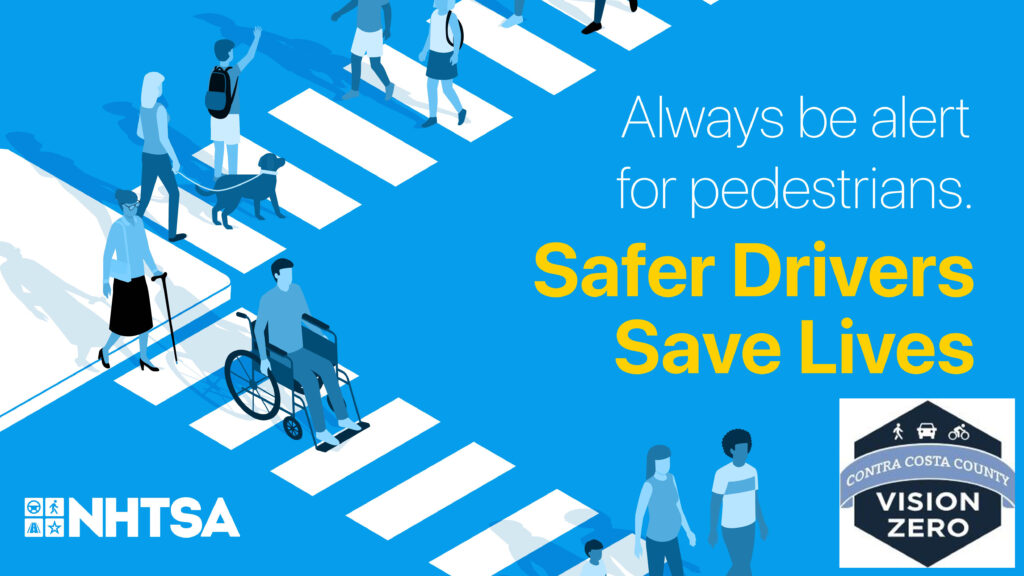By Tim Haile, Executive Director, Contra Costa Transportation Authority
October marks Pedestrian Safety Month, an ideal time to shed light on pedestrians’ safety challenges while navigating our roads. With California’s diverse landscapes, vibrant cities, and outdoor lifestyle, the state naturally encourages walking and biking, while also facing some alarming statistics regarding pedestrian safety.
According to preliminary data from the Governor’s Highway Safety Association, California’s pedestrian fatality rate is significantly higher than the national rate coming in at 1.29 per 1000,000. 504 pedestrians were killed in crashes involving vehicles in California in 2022, a nearly 10% increase over 2019.
As Executive Director of Contra Costa Transportation Authority (CCTA), I find these numbers to be unacceptable. During Pedestrian Safety Month, it’s crucial to recognize the importance of safeguarding our most vulnerable road users: pedestrians. Every day, hundreds of Contra Costa residents walk to work, school, and leisure activities, contributing to our county’s sustainability and quality of life. The first step to making the streets safer for all is through smart transportation systems and plans.
CCTA, in partnership with Contra Costa County, is actively addressing these concerns through the Vision Zero Safety Policy and Implementation Guide. Vision Zero is a comprehensive strategy aimed at eliminating all traffic fatalities and severe injuries while promoting safe, healthy, and equitable mobility for all. Vision Zero has become a guiding principle in our efforts to enhance pedestrian safety. The key to Vision Zero’s success lies in its data-driven approach, which identifies high-risk areas and factors contributing to pedestrian collisions. By analyzing these insights, we can implement targeted interventions that prioritize the safety of our residents.
In our ongoing commitment to pedestrian safety, CCTA is also in the process of developing a Countywide Transportation Safety Action Plan. The plan will identify strategies to eliminate severe injuries and fatalities. It will consider how to improve safety for all people in the County, including people biking, driving, walking, and taking the train or bus, as well as freight transportation. This plan considers the insights and feedback received from our residents, ensuring that it reflects the real-world experiences and concerns of those who use our streets daily. Residents can use the CCTA’s map-based tool to show where safety is a concern for pedestrians, cyclists, motorists or people with disabilities.
Pedestrian safety also starts with you. Drivers play a pivotal role in ensuring the well-being of those on foot. Drivers can prevent death and injury by adhering to speed limits and slowing down at intersections, always being prepared to stop at marked and unmarked crosswalks, refraining from blocking crosswalks while waiting to turn, and never driving under the influence of alcohol or drugs. By following these guidelines, drivers can actively contribute to a safer environment for pedestrians and all road users, reducing the risk of collisions and promoting a culture of responsible and attentive driving.
When walking, it’s vital to prioritize safety by remaining alert and attentive, avoiding distractions. Whenever possible, make use of designated signalized crosswalks, as these are locations where drivers are more likely to anticipate pedestrian activity. Keep a vigilant eye out for approaching vehicles and always exercise caution when crossing streets.
As we celebrate Pedestrian Safety Month, let us not only acknowledge the importance of pedestrian safety but also recognize the role of efficient transportation planning and community input in achieving this critical goal. By prioritizing safety, investing in infrastructure, and fostering a culture of responsible transportation, we can ensure that pedestrians can move about our beautiful county with confidence, knowing that their safety is a top priority.



I would really like to see CCTA move the conversation and the costly spending from “innovative” autonomous vehicle tech to low-cost quick-build protected bike and ped infrastructure. Painted lines are not protection. Sharrows are not protection.